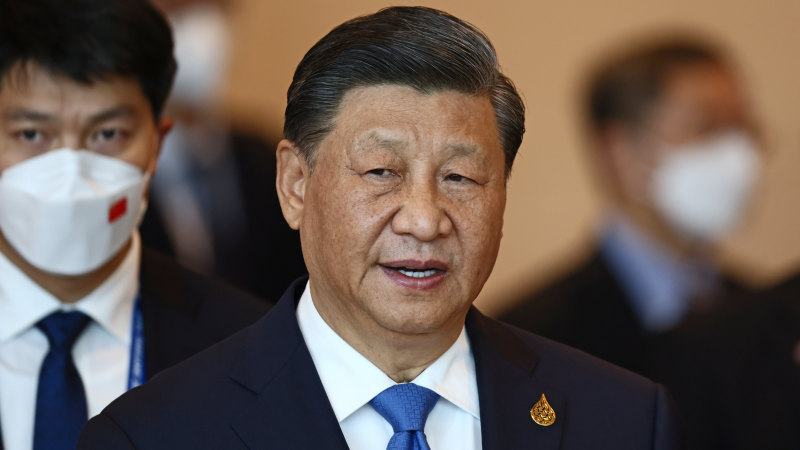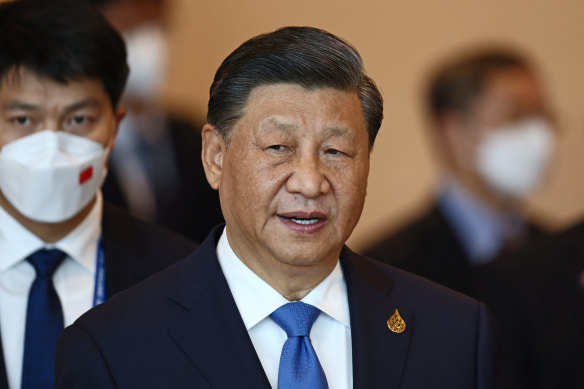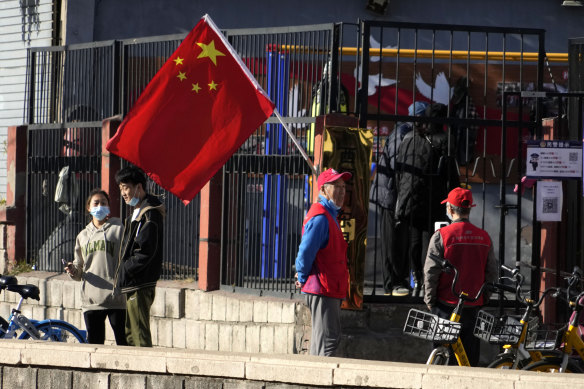The mass protests in the streets of China’s major cities are occurring even as COVID infections are hitting record levels, with negative implications for an already-struggling economy. China is caught in a bind largely of its own making.
With more than 400 million thought to be in lockdown and the virus breaking out in the major cities and industrial centres, the consequences of Beijing’s harsh zero-COVID policies, its stubborn reliance on vaccines developed within China and a healthcare system not equipped to deal with mass outbreaks of COVID have created unpalatable options for the authorities.
Xi Jinping is struggling to get China’s economy back on track.Credit:AP
They are proving to be equally unpalatable for Chinese citizens, with protests spreading across China in a demonstration of defiance against the authoritarian regime that is being described as the most significant since Tiananmen Square.
The wave of discontent was triggered by a deadly fire in Urumqi, the capital of the Xinjiang region of north-west China, in which 10 people died.
The protestors blame the severe lockdown measures, which include the bolting of doors on apartment blocks and steel barricades to restrict movement, for the inability of firefighting vehicles to enter the apartment compound.
The tolerance of the measures for those who have faced nearly three years of rolling lockdowns appears to be breaking down.
Last month workers within the Foxconn campus at Zhengzhou in Hennan province – known as “iPhone City” – were involved in violent clashes with security forces over a lockdown and protests about unpaid wages. Many thousands fled the compound, which can house as many as 300,000 workers.
There were reports that as many as 20,000 Foxconn workers, tired of the COVID restrictions and claiming that they had been misled about their wages, left the complex that accounts for the vast majority of iPhone production last week. Foxconn offered 10,000 yuan (about $2000) to protestors if they resigned and left the compound.
While the events at Foxconn (which will impact Apple’s ability to meet the usual surge in demand for its phones at Christmas) are a particularly high-profile instance, they illustrate the disruption to China’s society and economy being generated by the latest breakouts of COVID and the authorities’ responses to them.
The authorities have little flexibility. China has so far refused to access the mRNA vaccines that have proved to be the most effective in combating the evolving strains of the virus, instead relying on vaccines developed within China that are less effective, particularly for older people. China’s elderly have also been less enthusiastic about being vaccinated than their western counterparts.
China’s economy was already battered before the latest wave of infections. Credit:AP
With a hospital system that would be overwhelmed if COVID were allowed to spread freely, as is now the case in most other major economies – there is an acute shortage of beds, particularly intensive-care beds – the authorities have no option but to maintain stringent lockdowns as their primary response to outbreaks even though that means there is, as a result, a low level of immunity within its communities.
The authorities had foreshadowed some relaxation of the zero-COVID approach after last month’s Communist Party national congress saw Xi Jinping securing his unprecedented third term as general secretary and party leader but have again resorted to draconian measures in response to the latest outbreaks.
China’s economy was struggling under the weight of the zero-COVID policy even before the latest wave of infections. The combination of the impacts of the lockdowns and the collapse of property market activity (and the consequent dire condition of the major property developers) had depressed economic activity.
With more than 20 per cent of the economy, including major economic centres like Shanghai and Beijing, under full or partial lockdowns – more than double the level a month ago and growing – there is a possibility that China’s already weak GDP growth could turn negative in the December quarter.
If China is unable or unwilling to do as most of the major economies have done and be prepared to live with COVID, then the harsh lockdowns will continue to depress economic activity, impact supply chains like Apple’s that are reliant on China and contribute to the global slowdown.
That’s despite renewed efforts over the past week to stabilise a property sector that accounts for more than a quarter of GDP.
The sector was destabilised by a heavy-handed crackdown on leverage within the development sector, which caused a cascade of defaults by developers, and left a massive pile of uncompleted developments and hordes of angry customers who have been left with mortgages for properties that may never be completed.
There have been several attempts to arrest the property market’s decline, including some as recently as last week.
State-owned banks have been instructed to lend more for housing and China’s central bank has directed banks to hold less capital for emergencies and lend the funds for housing instead. New bonds being issued by some developers are being guaranteed by government-owned entities and they are being given new lines of credit by state-owned banks. There are new capital gains tax breaks for apartment buyers.
Protests are spreading across China in a demonstration of defiance against Beijing.Credit:AP
Chinese consumers are, however, increasingly cautious, for obvious reasons, and domestic economic activity is weak.
So are China’s exports, which fell in October. Exports to the US were down 12.6 per cent relative to October last year. With rapidly rising interest rates in the major western economies and the impact of the war in Ukraine on energy and food prices, global economic activity is slowing.
China is the world’s manufacturing base, so it is experiencing the fallout from that slowdown. Industrial profits for the 10 months to October were down three per cent and the decline accelerated in October, squeezed by the domestic lockdowns and the weak external demand.
If China is unable or unwilling to do as most of the major economies have done and be prepared to live with COVID, then the harsh lockdowns will continue to depress economic activity, impact supply chains like Apple’s that are reliant on China and contribute to the global slowdown.
Unhappily for China, and the protestors, while the strategy China adopted in response to the pandemic might have minimised the number of deaths from COVID, until more effective vaccines are deployed and the infrastructure of its healthcare system is significantly improved, the authorities have limited ability to do anything other than respond to the current outbreak – and future outbreaks – as they have in the past.
The Business Briefing newsletter delivers major stories, exclusive coverage and expert opinion. Sign up to get it every weekday morning.
Most Viewed in Business
From our partners
Source: Read Full Article



